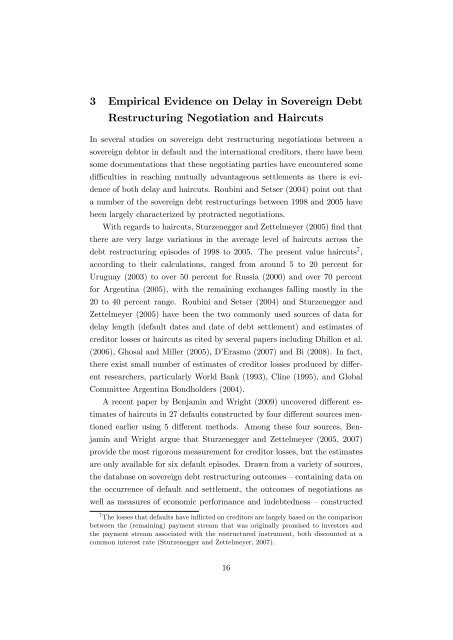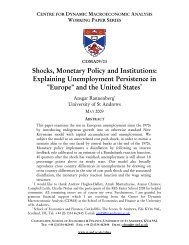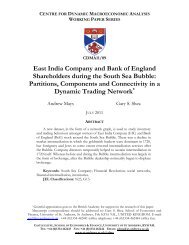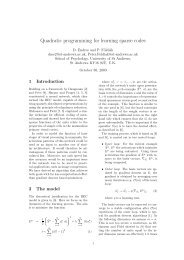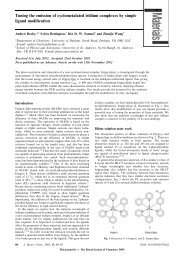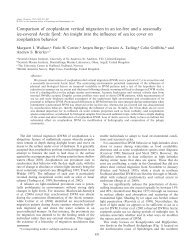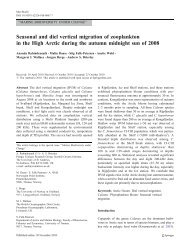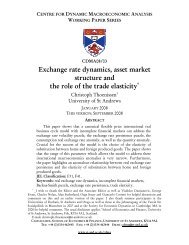Delay and Haircuts in Sovereign Debt - University of St Andrews
Delay and Haircuts in Sovereign Debt - University of St Andrews
Delay and Haircuts in Sovereign Debt - University of St Andrews
Create successful ePaper yourself
Turn your PDF publications into a flip-book with our unique Google optimized e-Paper software.
3 Empirical Evidence on <strong>Delay</strong> <strong>in</strong> <strong>Sovereign</strong> <strong>Debt</strong><br />
Restructur<strong>in</strong>g Negotiation <strong>and</strong> <strong>Haircuts</strong><br />
In several studies on sovereign debt restructur<strong>in</strong>g negotiations between a<br />
sovereign debtor <strong>in</strong> default <strong>and</strong> the <strong>in</strong>ternational creditors, there have been<br />
some documentations that these negotiat<strong>in</strong>g parties have encountered some<br />
di¢ culties <strong>in</strong> reach<strong>in</strong>g mutually advantageous settlements as there is evidence<br />
<strong>of</strong> both delay <strong>and</strong> haircuts. Roub<strong>in</strong>i <strong>and</strong> Setser (2004) po<strong>in</strong>t out that<br />
a number <strong>of</strong> the sovereign debt restructur<strong>in</strong>gs between 1998 <strong>and</strong> 2005 have<br />
been largely characterized by protracted negotiations.<br />
With regards to haircuts, <strong>St</strong>urzenegger <strong>and</strong> Zettelmeyer (2005) …nd that<br />
there are very large variations <strong>in</strong> the average level <strong>of</strong> haircuts across the<br />
debt restructur<strong>in</strong>g episodes <strong>of</strong> 1998 to 2005. The present value haircuts 7 ,<br />
accord<strong>in</strong>g to their calculations, ranged from around 5 to 20 percent for<br />
Uruguay (2003) to over 50 percent for Russia (2000) <strong>and</strong> over 70 percent<br />
for Argent<strong>in</strong>a (2005), with the rema<strong>in</strong><strong>in</strong>g exchanges fall<strong>in</strong>g mostly <strong>in</strong> the<br />
20 to 40 percent range. Roub<strong>in</strong>i <strong>and</strong> Setser (2004) <strong>and</strong> <strong>St</strong>urzenegger <strong>and</strong><br />
Zettelmeyer (2005) have been the two commonly used sources <strong>of</strong> data for<br />
delay length (default dates <strong>and</strong> date <strong>of</strong> debt settlement) <strong>and</strong> estimates <strong>of</strong><br />
creditor losses or haircuts as cited by several papers <strong>in</strong>clud<strong>in</strong>g Dhillon et al.<br />
(2006), Ghosal <strong>and</strong> Miller (2005), D’Erasmo (2007) <strong>and</strong> Bi (2008). In fact,<br />
there exist small number <strong>of</strong> estimates <strong>of</strong> creditor losses produced by di¤erent<br />
researchers, particularly World Bank (1993), Cl<strong>in</strong>e (1995), <strong>and</strong> Global<br />
Committee Argent<strong>in</strong>a Bondholders (2004).<br />
A recent paper by Benjam<strong>in</strong> <strong>and</strong> Wright (2009) uncovered di¤erent estimates<br />
<strong>of</strong> haircuts <strong>in</strong> 27 defaults constructed by four di¤erent sources mentioned<br />
earlier us<strong>in</strong>g 5 di¤erent methods. Among these four sources, Benjam<strong>in</strong><br />
<strong>and</strong> Wright argue that <strong>St</strong>urzenegger <strong>and</strong> Zettelmeyer (2005, 2007)<br />
provide the most rigorous measurement for creditor losses, but the estimates<br />
are only available for six default episodes. Drawn from a variety <strong>of</strong> sources,<br />
the database on sovereign debt restructur<strong>in</strong>g outcomes –conta<strong>in</strong><strong>in</strong>g data on<br />
the occurrence <strong>of</strong> default <strong>and</strong> settlement, the outcomes <strong>of</strong> negotiations as<br />
well as measures <strong>of</strong> economic performance <strong>and</strong> <strong>in</strong>debtedness – constructed<br />
7 The losses that defaults have <strong>in</strong>‡icted on creditors are largely based on the comparison<br />
between the (rema<strong>in</strong><strong>in</strong>g) payment stream that was orig<strong>in</strong>ally promised to <strong>in</strong>vestors <strong>and</strong><br />
the payment stream associated with the restructured <strong>in</strong>strument, both discounted at a<br />
common <strong>in</strong>terest rate (<strong>St</strong>urzenegger <strong>and</strong> Zettelmeyer, 2007).<br />
16


